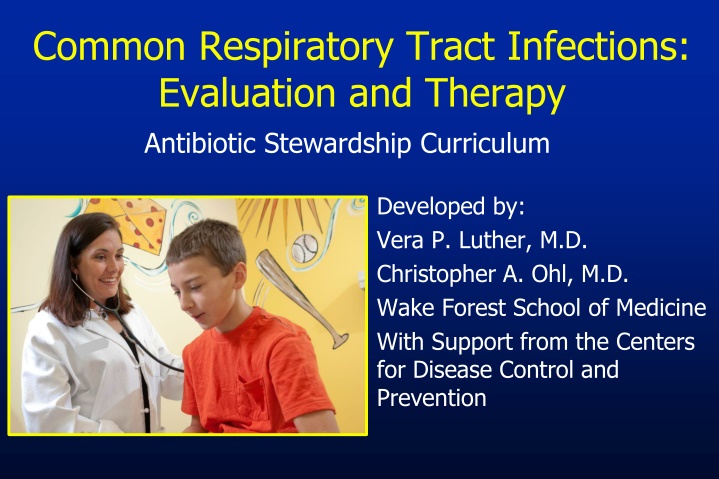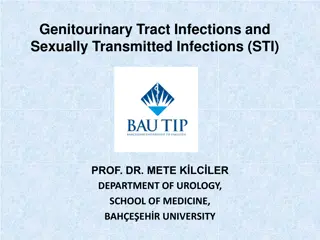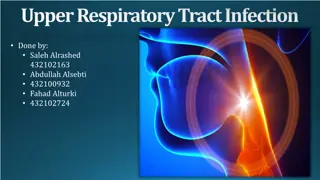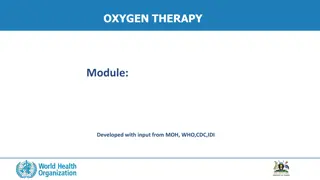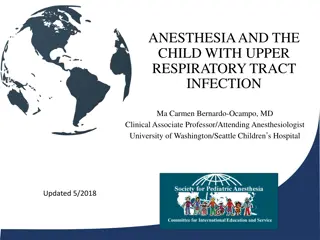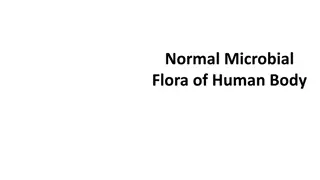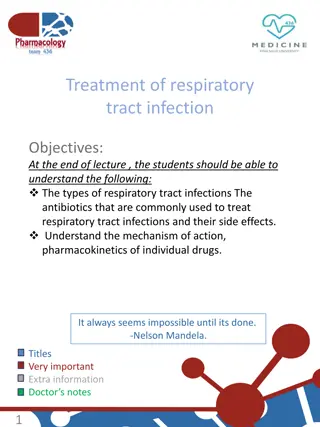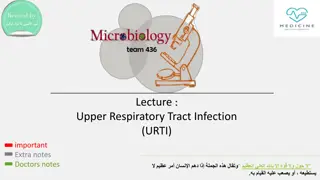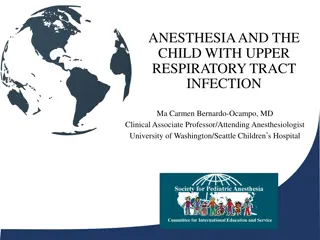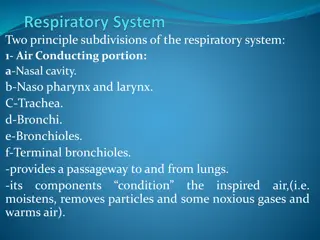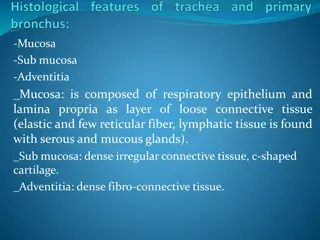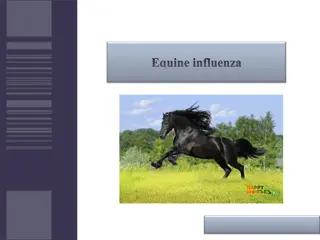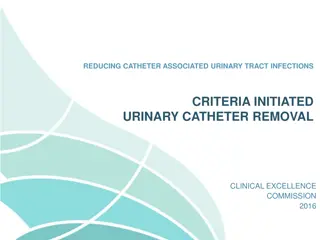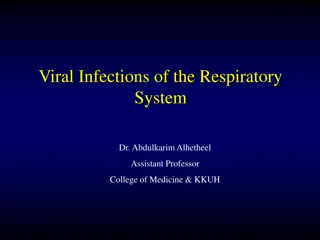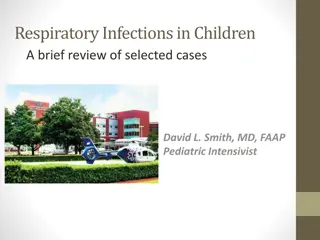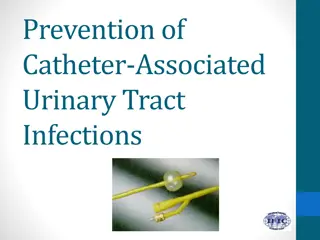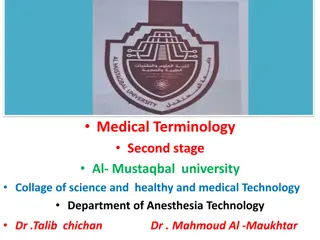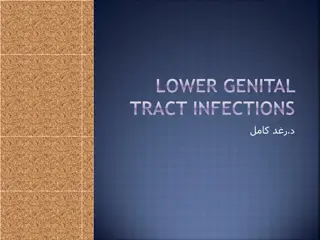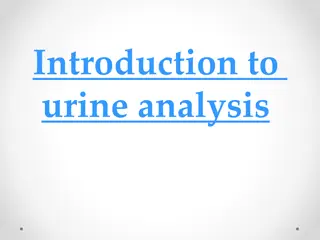Evaluation and Therapy of Common Respiratory Tract Infections
This curriculum focuses on the etiology, diagnosis, and treatment of community-acquired pneumonia, acute bronchitis, rhinosinusitis, pharyngitis, and acute otitis media. It also covers criteria for symptomatic and antibiotic therapy, along with first-line antibiotic choices for each condition.
Download Presentation

Please find below an Image/Link to download the presentation.
The content on the website is provided AS IS for your information and personal use only. It may not be sold, licensed, or shared on other websites without obtaining consent from the author.If you encounter any issues during the download, it is possible that the publisher has removed the file from their server.
You are allowed to download the files provided on this website for personal or commercial use, subject to the condition that they are used lawfully. All files are the property of their respective owners.
The content on the website is provided AS IS for your information and personal use only. It may not be sold, licensed, or shared on other websites without obtaining consent from the author.
E N D
Presentation Transcript
Common Respiratory Tract Infections: Evaluation and Therapy Antibiotic Stewardship Curriculum Developed by: Vera P. Luther, M.D. Christopher A. Ohl, M.D. Wake Forest School of Medicine With Support from the Centers for Disease Control and Prevention
Objectives 1. Review the etiology, diagnosis and therapy of 5 common respiratory tract infections: community- acquired pneumonia, acute bronchitis, rhinosinusitis, pharyngitis, and acute otitis media (AOM) 2. List criteria for symptomatic therapy 3. List criteria for each of the 5 conditions that indicate antibiotic therapy is the most appropriate treatment 4. List the first line antibiotic therapy for each of the 5 conditions when indicated
Outline Introduction Evaluation and therapy Community-acquired pneumonia Acute bronchitis Rhinosinusitis Acute pharyngitis AOM Conclusion
Common Respiratory Tract Infections Community-acquired pneumonia Acute bronchitis Pharyngitis Rhinosinusitis AOM
Respiratory Infections are the Most Common Reason for Office Visits 180 161 100 Number of Office Visits 80 73 (millions) 55 60 35 40 26 20 0 Respiratory Hypertension Gastrointestinal Diabetes Depression Infections Disorders IMS America NDTI (National Disease Therapeutics Index) 2001. Mehrotra A. Health Affairs 2008 Sep-Oct;27(5):1272-82.
Over half of Antibiotic Use in Adults is for Respiratory Tract Infections Adult Oral Antibiotic Use by Diagnosis Bronchitis Sinusitis Pharyngiits Pneumonia Otitis Media UTI Skin/soft tissue Abdominal/pelvic Other 2004-2005 Physician Drug & Diagnosis Audit (PDDA)
Percent of physician office visits made by children under 15 years of age where an antibiotic was prescribed by primary diagnosis, United States 11 11 URI Otitis media 31 42 Pharyngitis 26 Bronchitis Sinusitis 34 Other 6 5 11 8 8 7 2007-08 1993-94 NOTE: Figures are based on 2-year averages. SOURCE: CDC/NCHS, National Ambulatory Medical Care Survey 1993-94 and 2007-08
Burden of Acute Respiratory Tract Infections Significant time away from school and work Significant healthcare expenditures for clinic visits, hospitalization and medications Mortality rare except for community-acquired pneumonia in persons with comorbidities
Pathogens Respiratory viruses account for the majority of infections Bacterial infections are more prominent in acute otitis media and pneumonia Streptococcus pneumoniae Moraxella catarrhalis Mycoplasma sp. Haemophilus influenzae Streptococcus pyogenes Chlamydiophila sp. Antibiotic resistance is common among S. pneumoniae, H. influenzae, and M. catarrhalis isolates
Proportion of Resistant Invasive Streptococcus pneumoniae spp., 1992-2008 Percent Fully Resistant Source: CDC Active Bacterial Core Surveillance and Sentinel Surveillance Network. Erythromycin resistance data not available
Outline Introduction Evaluation and therapy Community-acquired pneumonia Acute bronchitis Rhinosinusitis Acute pharyngitis Acute otitis media Conclusion
Community- Acquired Pneumonia
Community-Acquired Pneumonia Overview 3-4 million cases/year 10 million patient visits/year Approximately 80% are mild to moderate in severity and treated as outpatients 500,000 hospitalizations and 45,000 deaths/year (8th leading cause of death) Mortality 1% in outpatients 5% in inpatients 25-50% in patients admitted to ICU File TM, Marrie TJ Postgrad Med 2010;122(2):130.
Community-Acquired Pneumonia Symptoms Cough Fever Pleuritic chest pain Dyspnea Sputum production
Community-Acquired Pneumonia Diagnosis Common physical examination findings Fever Respiratory rate > 24 breaths/minute Heart rate > 100 beats/minute Crackles/r les usually present on auscultation Evidence of consolidation on exam Peripheral white blood cell count (WBC) usually elevated Chest x-ray (CXR) should be used to confirm diagnosis
Community-Acquired Pneumonia Microbiology and Proportion of Deaths in Adults Proportion of Hospital Admissions 20-60% 3-10% 3-5% 3-10% 3-5% 10-20% 2-8% 1-6% 4-6% 2-15% 6-10% Microbial Agent S. pneumoniae H. influenzae S. aureus Gram Negative Rods Miscellaneous Bacteria Atypical Bacteria Legionella spp. Mycoplasma spp. C. pneumoniae Viral (including influenza) Aspiration Deaths 66% 7% 6% 3% 9% 6% 5% 1% <1% <1% ND
Antibiotic Considerations Therapy is almost always empiric initially Most important pathogen to target is S. pneumoniae based on its frequency and associated morbidity and mortality Local prevalence of macrolide- resistant S. pneumoniae influences antibiotic choice Atypical pathogens more common among older children and adults Sputum gram-stain showing the typical lancet-shaped gram positive diplococci of S. pneumoniae If an etiology is identified, therapy should be de-escalated and directed at that pathogen
Community-Acquired Pneumonia Treatment Recommendations for Outpatients Clinical Characteristic Previously healthy and no risk factors for drug-resistant S. pneumoniae Risk factors for drug resistant S. pneumoniae Presence of comorbidities or immunocompromised Use of antimicrobials within the previous 3 months Regions with a high rate (>25%) of macrolide-resistant S. pneumoniae Treatment Regimen Macrolide* Doxycycline Respiratory fluoroquinolone** High dose amoxicillin plus macrolide* Amoxicillin/clavulanate plus macrolide* Alternative: Ceftriaxone, cefpodoxime or cefuroxime plus macrolide* * Azithromycin, Clarithromycin or Erythromycin ** Gemifloxacin, Levofloxacin or Moxifloxacin Mandell et al. Clin Infect Dis 2007. 44: S27-S72
Community-Acquired Pneumonia Treatment Recommendations for Inpatients Clinical Characteristic Non-ICU Admission Treatment Regimen Respiratory fluoroquinolone** Cefotaxime or ceftriaxone plus macrolide* Ampicillin plus macrolide* Ertapenem plus macrolide* Cefotaxime or ceftriaxone or ampicillin-sulbactam PLUS Azithromycin or fluoroquinolone ICU Admission * Azithromycin, Clarithromycin or Erythromycin ** Gemifloxacin, Levofloxacin or Moxifloxacin Mandell et al. Clin Infect Dis 2007. 44: S27-S72
Community-Acquired Pneumonia: Reasons for Overtreatment Community-acquired pneumonia is commonly misdiagnosed Abnormal findings on chest radiographs often lead to cannot rule out pneumonia e.g. atelectasis, malignancy, hemorrhage, pulmonary edema, heart failure, pulmonary embolism, effusions, fibrosis Emergency department protocols are designed to expedite therapy Pines, et. al. J Emerg Med. 2009 Oct;37(3):335-40.
Acute Bronchitis
Acute Bronchitis Definition: An acute respiratory tract infection that may last up to 3 weeks in which cough, with or without phlegm, is a predominant feature and alveolar inflammation is not present (normal chest radiograph) Occurs predominately in the late fall, winter and early spring Common: Up to 5% of adults self report an episode each year Gonzales et al. Annals of Int Med. 2001;134(6):521 Brahman. Chest 2006;129:95S-103S
Acute Bronchitis Almost Always a Viral Etiology Less than 10% due to bacterial causes Etiologic diagnosis not usually attempted unless influenza suspected Antibiotic therapy not indicated and should not be offered Exception: some episodes of prolonged paroxysmal cough are due to Bordetella pertussis Viral Causes of Bronchitis Respiratory Syncytial Virus Adenovirus Parainfluenza virus Rhinovirus Influenza virus Gonzales et al. Annals of Int Med. 2001;134(6):521 Brahman. Chest 2006;129:95S-103S
Patient Management Some patients may expect an antibiotic based on past experience or expectations Explain to the patient why an antibiotic is not necessary and that these drugs may have unwanted side-effects Use terms like chest cold rather than bronchitis or infection Suggestions for symptom relief Humidified air Over-the-counter pain relievers Some recommend cough suppressants No role for bronchodilators in absence of asthma or chronic obstructive pulmonary disease (COPD)
Acute Rhinosinusitis (ARS)
Acute Rhinosinusitis Broad term describing multiple disease processes affecting the nasal cavity and sinuses with a duration of <4 weeks Allergy Infection (viral, bacterial, fungal) Polyps Frequent: 1 of 7 adults per year seeks medical attention for acute rhinosinusitis (ARS) Chow et al. Clin Infect Dis. 2012; 54(8):e72-112
Acute Viral Rhinosinusitis (Common Cold) Pathogens: Viruses similar to acute bronchitis Common symptoms: Nasal congestion and mucous discharge, facial pressure, post-nasal discharge Usually symptoms peak at 2-3 days and resolve by day 7-10 Diagnosis relies on exam: radiographs not sensitive or specific Treat with topical and oral decongestants, nasal irrigation, +/- topical corticosteroids No indication for antibiotics Meltzer et. al. Mayo Clin Proc. 2011 86: 427 Chow et al. Clin Infect Dis. 2012; 54(8):e72-112
Acute Bacterial Rhinosinusitis (ABRS) Pathogens: S. pneumoniae, H. influenzae, M. catarrhalis, Streptococcus sp, S. aureus, anaerobes Much less frequent than viral ARS Follows <2.0% of viral ARS cases Important to attempt to differentiate from viral ARS CT imaging indicated for severe infection with suspected orbital or intracranial extension Symptoms Suggesting Bacterial Infection Symptoms > 10 days Unilateral maxillary face pain Maxillary tooth ache Unilateral maxillary sinus tenderness Unilateral purulent nasal discharge Double sickening (symptoms improve then worsen) Green or colored nasal discharge and cough do not predict ABRS. Meltzer et. al. Mayo Clin Proc. 2011 86: 427 Chow et al. Clin Infect Dis. 2012; 54(8):e72-112
ABRS treatment First-line antibiotic therapy: Amoxicillin-clavulanate Penicillin allergy: doxycycline, levofloxacin or moxifloxacin Adjunctive treatment Hydration, analgesics, antipyretics Irrigation with physiologic or hypertonic saline Intranasal corticosteroids for those with concurrent allergic rhinitis Topical or oral decongestants or antihistamines not indicated due to lack of effect Meltzer et. al. Mayo Clin Proc. 2011; 86: 427, Young J et al. Lancet. 2008; 371:908, Chow et al. Clin Infect Dis. 2012; 54(8):e72-112
Acute Pharyngitis Classically the triad of fever, sore throat and pharyngeal inflammation Pathogens: Viruses: Epstein-Barr, Cytomegalovirus, respiratory viruses, enteroviruses, Herpes simplex type I Bacteria: Group A Streptococcus (GAS), Non-group A Streptococcus, Arcanobacterium hemolyticum, and Fusobacterium spp. Pharyngitis in 85-95% of adults and 80-85% of children is due to viruses For uncomplicated pharyngitis, antibacterial therapy is reserved for GAS infection
Clinical Features of Pharyngitis Features suggestive of GAS etiology Sudden onset sore throat Fever Headache Tonsillopharyngeal inflammation Tonsillopharyngeal exudate Palatal petechiae Tender anterior cervical adenopathy Winter-early spring presentation Age 5-15 years History of exposure to GAS pharyngitis Features suggestive of viral etiology Absence of fever Conjunctivitis Coryza Cough Hoarseness Ulcerative mouth lesions Viral type rash Overlap between GAS and viral pharyngitis may be considerable McIsaac et al. JAMA. 2004; 291:1587, Bisno et al. Clin Infect Dis. 2002; 35:113
Acute Pharyngitis Diagnosis For adults and children with features that strongly suggest a viral etiology, testing is not indicated In persons with findings suggestive of GAS infection, confirmation with a rapid antigen detection test (RADT) or culture is needed In children and adolescents a negative RADT has a low negative predictive value and should be backed up with a throat culture for GAS McIsaac et al. JAMA. 2004; 291:1587, Bisno et al. Clin Infect Dis. 2002; 35:113
Acute Pharyngitis Treatment Antibiotics for those with confirmed GAS Penicillin or amoxicillin Penicillin allergic: first generation cephalosporin for minor allergy and clindamycin or macrolide if anaphylaxis No GAS resistance to penicillin has been reported Symptomatic treatment: Over-the-counter pain relievers/antipyretic Throat lozenges or sprays Adequate oral hydration Corticosteroids not recommended
Acute Otitis Media (AOM) Acute illness with fluid and mucosal inflammation of the middle ear space Extremely common in young children: By age 3, two-thirds have had at least one episode Much less common in adults Increased risk with some ethnic groups, exposure to polluted air (including tobacco smoke), and with children who attend daycare
Acute Otitis Media Pathogenesis: Anatomic and physiologic disruption of eustachian tube drainage of the middle ear with subsequent fluid accumulation and bacterial infection Often follows viral respiratory infection Incidence due to S. pneumoniae decreasing due to vaccination of children starting in 2000 Pathogen S. pneumoniae H. influenzae M. catarrhalis Group A Streptococcus None Proportion of cultures (2001-2003) (%) 23 36 3 1.3 41 Adapted from Casey et. al. Pediatr Infect Dis J. 2004; 23:824
Acute Otitis Media Symptoms/signs Fever, chills, ear pain, ear drainage, hearing loss, lethargy, irritability, pulling on ear Exam Tympanic membrane erythema, loss of landmarks and bulge Presence of middle ear fluid on pneumatic otoscopy or tympanometry, or otorrhea
Acute Otitis Media: Treatment Many cases of AOM (~25%) are due to viruses and will not respond to antibiotics A significant number of cases due to bacteria will spontaneously resolve without antibiotics If antibiotics are indicated, use high dose amoxicillin Severe illness: Amoxicillin-clavulanate Penicillin allergy: 2nd or 3rd generation cephalosporin, azithromycin or clarithromycin AAP. Pediatrics. 2004; 113:1451
Acute Otitis Media Treatment Age Certain Diagnosis Uncertain Diagnosis <6 mo 6 mo -2 yr Antibacterial therapy Antibacterial therapy Antibacterial therapy Antibacterial therapy if severe illness; observation option if non-severe illness Observation option 2 yr Antibacterial therapy if severe illness; observation option if non-severe illness AAP. Pediatrics. 2004; 113:1451
Acute Otitis Media Symptom relief Oral analgesics Topical analgesic spray/drops Warm, moist cloths over ear Avoid narcotics Prevention Conjugate pneumococcal and Haemophilus vaccination Influenza vaccination Rarely antibiotic prophylaxis for frequent recurrences
Outline Introduction Evaluation and therapy CAP Acute bronchitis Rhinosinusitis Acute pharyngitis Acute otitis media Conclusion
Conclusion Antibiotics are frequently given for respiratory tract infections in outpatient and inpatient settings Inappropriate antibiotic use is common for these diagnoses Misdiagnosis of pneumonia is common Most upper respiratory infections are viral and do not need antibiotic treatment Observation without antibiotics is an option for children with acute otitis media Guidelines exist for the appropriate treatment of respiratory tract infections
Treatment Guidelines and Resources Centers for Disease Control and Prevention (CDC) http://www.cdc.gov/getsmart/ Get Smart: Know When Antibiotics Work Adult Guideline Summaries Pediatric Guideline Summaries Infectious Diseases Society of America (IDSA) http://www.idsociety.org/IDSA_Practice_Guidelines/ American Academy of Pediatrics (AAP) American Academy of Family Physicians(AAFP)
